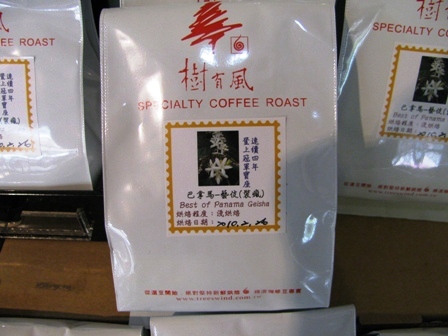Sometimes you come across a story that illustrates so many of the themes of agrobiodiversity conservation that it’s almost too good to be true. I have it on very good authority that the one I’m about to tell you is indeed true, though. The authority is the former head of the genebank at the Centro Agronómico Tropical de Investigación y Enseñanza in Costa Rica (CATIE), who is now the head of the genebank at The World Vegetable Centre (AVRDC) in Taiwan.
He told me the story over coffee at the Trees Wind cafe in Tainan City, a short ride from AVRDC’s headquerters. The story is about the coffee he was drinking. I was drinking a very superior arabica from the highlands of Taiwan. But that’s another story, or at least a different aspect of the story. The coffee my host was drinking is called Geisha and it comes from Hacienda Esmeralda in Panama.
He discovered it by chance at Trees Wind when he first moved to AVRDC a year and a half ago and was exploring the surroundings. The name jumped out at him from the menu because he knew it from his days managing the CATIE coffee collection. The owner of Esmeralda had visited the CATIE genebank some years back, looking for coffee germplasm to try out. He’d been growing coffee for decades, having originally got his material from CATIE, but he was now expanding into a higher altitude plantation and wanted new varieties to try. He settled on an accession called Geisha. Nothing to do with Japan, though: this is an Ethiopian landrace, very low yielding, but very high quality; and from the right sort of altitude.
My host didn’t hear much after that about how the material he sent out to Panama fared. Not until, that is, he sampled a cup of the stuff in Tainan some years later. And an expensive cup it is too: 225g of beans will set you back TWD 1800 (USD 56). Coffee is now also grown in Taiwan, along with tea. The stuff I had was great, and about a third of the price of Geisha from Panama, though on a par with interesting brands from Ecuador, Ethiopia and Indonesia.
So, material collected in Ethiopia probably back in the 70s by an international FAO mission, conserved at a regional research institute in Costa Rica, grown in Panama, marketed around the world, and finally sipped in Taiwan by people whose stimulant of choice was quite different until fairly recently, in competition with material from a dozen other countries on three continents. Quite a journey. Quite a lesson in agrobiodiversity interdependence, conservation and use.

